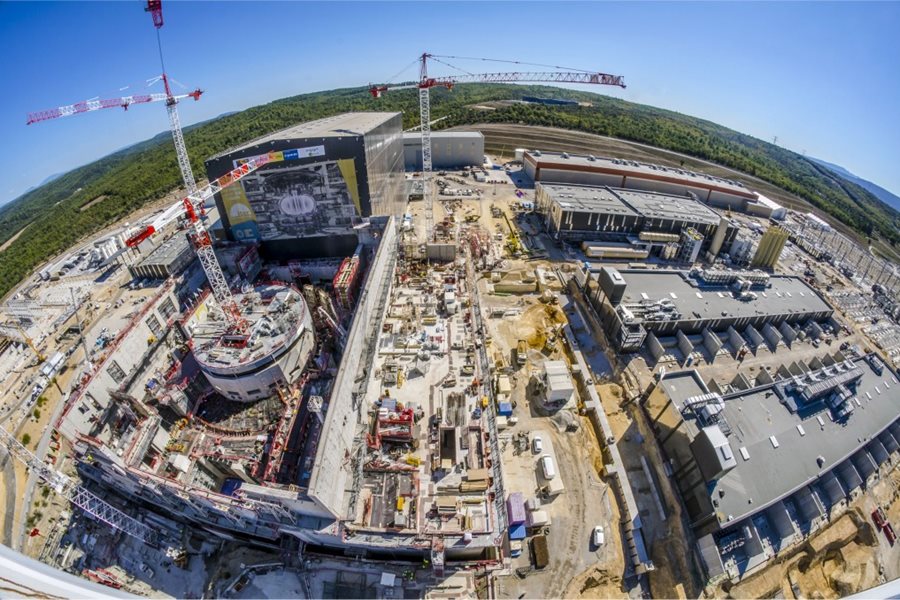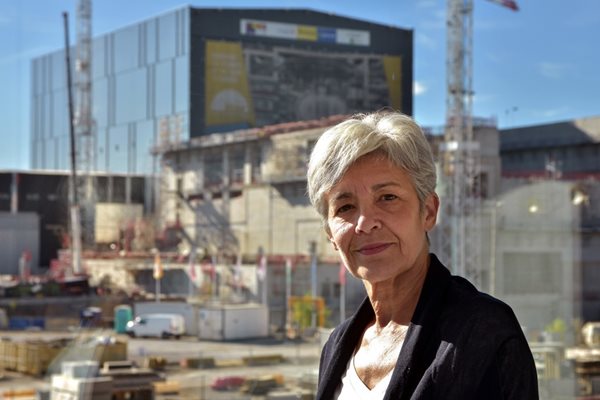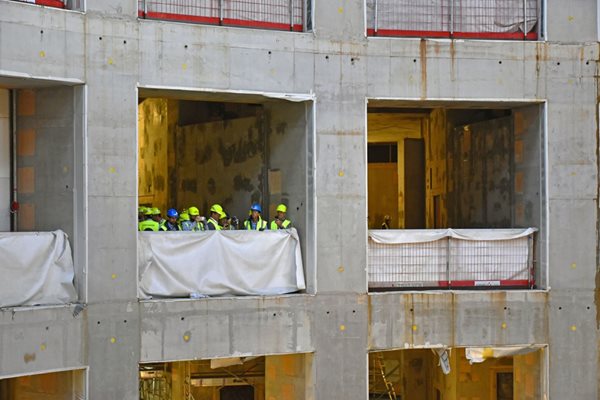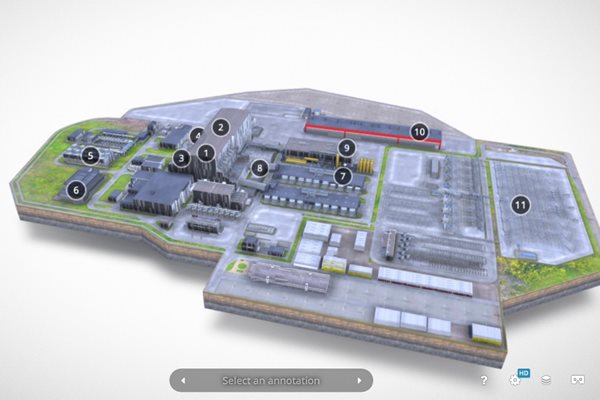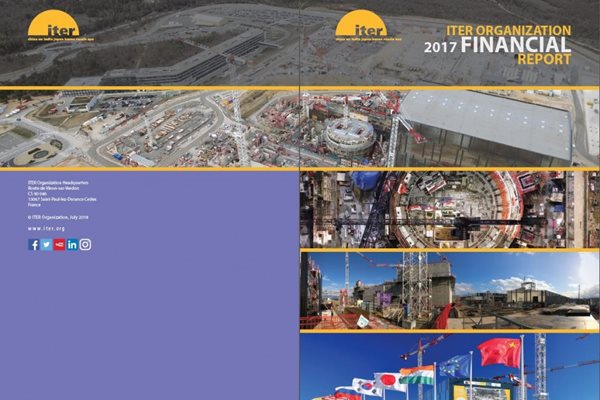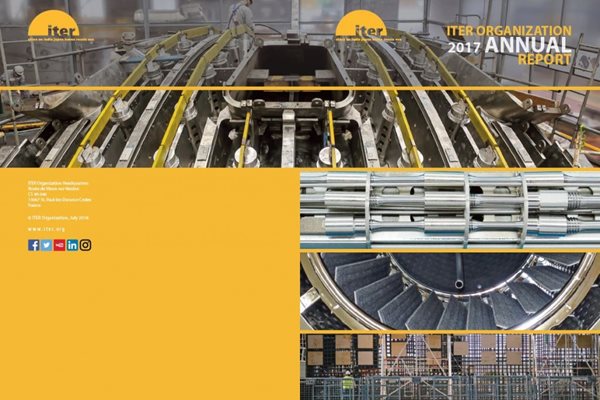
you're currently reading the news digest published from 01 Oct 2018 to 08 Oct 2018
featured4
of-interest1
publication2
press6
featured
Worksite progress | A view from the belfry
If ITER were a small town (and in a way it is), crane C5 would be the belfry—the spectacular vantage point from which to take it all in. From a height of some 80 metres, by the light of a midafternoon in October, buildings, vehicles, lifting fixtures and people at work are revealed in sharp detail. The small town is booming with activity, its dwellers dwarfed by the giant structures that surround them: to the left, the 60-metre-high Assembly Hall and the circular bioshield ressembling a jewel in its box; to the right, part of the industrial infrastructure (power conversion, cryoplant, electrical switchyard) that will support machine operations. A sharp eye will notice that Crane C1, rising from the centre of the bioshield and materializing the axis of the ITER machine, stands taller than it used to: the optimized version of the building plan required its extension by approximately 10 metres. Compared to the view shot from the same location in July, progress on the Diagnostics Building (centre) is spectacular. The building has now reached its final height and most of the work is going on in the lower floors. The gallery below will tell you more ...
Donations | Now you can join the quest
Curiosity is a universal human trait. Scientific advancement is a globally shared endeavour. The race to harness fusion energy is also a global quest, and the success of the ITER Project stands to benefit future generations across human society. To expand the opportunity for people to get involved in ITER Project, we at ITER—like CERN, the World Academy of Sciences, and many other science research organizations before us—have decided to open the door for donations and sponsorships. The governments of ITER Member countries provide the funding for constructing the ITER machine and fabricating its more than one million components. So we cannot offer you the chance to manufacture a superconductor magnet or colossal vacuum pump or to design a precisely shaped tile of the plasma-facing Tokamak wall. But there are many other aspects of the ITER mission where your donations will make a meaningful difference. Donating to ITER will enhance our outreach capabilities, to inspire more people with the ITER quest for endless energy. It will support our educational programs, to bring innovative team projects like ITER Robots to more schoolchildren, and to create classroom modules and curricula at all levels to stimulate the next generation of plasma physicists and tokamak engineers from around the world. Or perhaps you have a specific idea about how you would like your donation to be used. Tell us. We'll listen. Many individuals of all types—Newsline readers, educators, scientists, everyday citizens—have written to us over the years asking whether they could donate. With a new donations and sponsoring policy in place, the answer is now yes. As of today, you can make a donation to the ITER Project on our donations page and become an active partner in our quest to deliver this new clean source of energy to the world. ITER is an unprecedented endeavour, with high stakes for all of humanity. By its nature, it should be a shared adventure. We invite you to join the ITER team.
Former minister and astronaut | "I can't think of a more meaningful project for the future of mankind"
During the year 2003 Claudie Haigneré, French minister of Research and New Technologies and a former astronaut¹, was a regular visitor to the Cadarache forest. There, near a mockup of the future ITER installation set up amid the venerable oaks and pines, she would tirelessly absorb the explanations provided by fusion scientists and affirm her 'determination' to see ITER become a reality ... on that very spot. The year 2003 was a decisive one for ITER. The United States, which had left the project in 1998, was back with renewed determination. China and Korea had joined the original four Members. And although Canada was not an ITER Member, a group of industries, universities and trade unions from Ontario had submitted the first bid to host the project. Japan was officially offering the site of Rokkasho Mura, and Europe had two sites to propose: Vandellòs in Spain and Cadarache in France. 'As Minister of Research, space policy and ITER were on the top of my agenda,' says Haigneré, who was on site last week to participate in the autumn assembly of the EIROForum (see box below). 'We needed to convince the ITER Members that because of the fusion expertise accumulated in Europe, and more specifically at CEA-Cadarache, this was the place to host the installation.' Haigneré was in Cadarache on 31 March 2003, accompanied by her then chief of staff Bernard Bigot; she was back three months later on 15 July to 'introduce the site' to European Commissioner Busquin, and once again on 17 November with French Prime Minister Raffarin. 'We were seeking a unanimous decision. We didn't want any country, any Member, to feel frustrated or 'dispossessed' from its own expertise. Once Europe had made its final choice in favour of Cadarache on 26 November 2003 and decided that Barcelona would host the future European Domestic Agency, I began touring the world to convince each and every Member of the merits and validity of our proposal.' Fifteen years later, back on the ITER site, Haigneré can take the full measure of what her past involvement has contributed to: the creation, against many odds, of the largest international science collaboration ever established and the construction of the most complex machine ever designed. 'I can't think of a more meaningful project for the future of mankind. ITER is something we cannot afford not to do.' For the former astronaut, presently a senior advisor to the Director General of the European Space Agency (ESA), ITER and space exploration are kin. 'What I feel today at ITER is very close to what I feel when a space project comes to a successful conclusion. It's a mix of awe and wonderment and a reflexion on all the effort and patience it took to get there. Take Rosetta for instance, the European space probe that landed on comet Churyumov-Gerasimenko in August 2014. We began planning in 1994 for a probe that was launched in 2003, and that reached the comet's orbit eleven years later ...' Large projects, whether space or energy-related, are necessarily long-term projects. 'Our society as a whole and certainly the political establishment may not always feel comfortable with complex projects that span several decades and whose success is not guaranteed. What we need is a form of pedagogy, because everything that really matters for our future takes a long time to come to fruition.' ¹ A medical doctor by training, Claudie Haigneré flew aboard both the Russian space station Mir (August 1996) and the International Space Station (October 2001) to carry out biological and medical experiments.
On site | "What you see is your achievement"
An unusually large number of visitors could be seen on the construction platform last week, identifiable by their yellow hardhats and vests. More than 120 staff of Fusion for Energy (F4E), the European Domestic Agency, toured the ITER worksite to witness the progress of the project and see—in very concrete terms—the fruit of all their efforts. Fusion for Energy is the largest of ITER's Domestic Agencies, employing about 500 staff at its headquarters in Barcelona, Spain, with some staff based at the ITER site and in Garching, Germany. It is responsible for providing Europe's 45.6 percent contribution to ITER—a contribution that includes the construction of nearly all concrete and steel-frame buildings, site infrastructure, and power supplies on site in addition to the procurement of a large number of high technology components and systems. The majority of Fusion for Energy staff visiting last week had made the trip from Barcelona, with some of their colleagues based in France joining them. They represented the two technical departments—the ITER Delivery Department and the ITER Programme Department—which are in charge of the in-kind procurement and delivery of the European contribution. Many were setting foot on the ITER platform for the first time while others had not been for several years. It was a real discovery tour for all, seeing the results of all their work rise spectacularly before them. In his address to visiting staff, ITER Director-General Bernard Bigot expressed his profound appreciation for their efforts: 'The platform is buzzing with activity, almost all of it under the responsibility of Fusion for Energy. So, what you see there is really your achievement.'
of-interest
Take a spin on the virtual ITER worksite
Want to see what the ITER platform will look like when all the buildings are complete? Check (and play with) this spectacular 3D model developped by the European Domestic Agency F4E. (Works best on Chrome)
